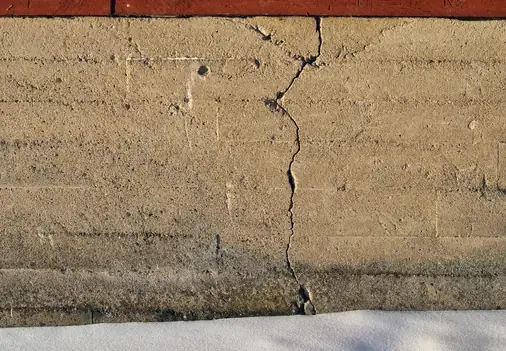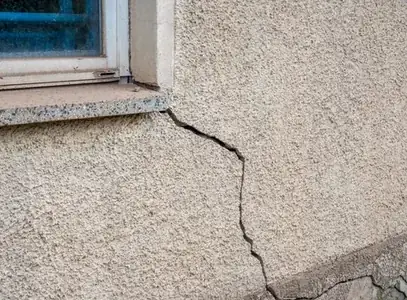Why Foundation Problems Develop in Toronto
Toronto's unique geological and climatic conditions create the perfect storm for foundation problems. Our city sits on varying soil types, from stable bedrock to problematic clay, while experiencing extreme temperature fluctuations that can cause soil expansion and contraction. Understanding these factors helps homeowners recognize when normal settling becomes serious structural concern.
Toronto Foundation Facts
The Insurance Bureau of Canada reports that foundation damage is one of the top three causes of homeowner insurance claims in Ontario, with Toronto experiencing above-average claim rates due to our clay soil and freeze-thaw cycles.
The 7 Critical Warning Signs
Cracks in Foundation Walls
Foundation wall cracks are the most obvious sign of structural problems. However, not all cracks are created equal. Understanding the difference between normal settling and serious structural issues is crucial.
Low Severity - Monitor
Typical Cause: Normal concrete settling and curing
High Severity - Act Now
Typical Cause: Soil pressure, foundation settling, structural movement
Quick Assessment Test
Place a coin (quarter = 1/8", nickel = 1/16") against the crack. If the crack is wider than a quarter, it requires immediate professional attention. Take photos and measure monthly to track growth.
Doors and Windows That Stick or Won't Close
Foundation movement affects the entire structure above it. When foundations settle unevenly or shift, it changes the geometry of door and window frames, causing them to bind or create gaps.
Sticking Doors
Doors require force to open or close, especially during humidity changes
Window Issues
Windows won't open, close improperly, or have visible gaps around frames
Visible Gaps
Daylight visible around closed doors/windows, uneven gaps in frames
Important Note
While seasonal wood expansion can cause minor sticking, persistent problems or multiple doors/windows affected simultaneously usually indicate foundation movement. Document which doors are affected and when problems occur.
Uneven or Sagging Floors
Floor problems often indicate serious foundation issues. When foundations settle unevenly, the floors above reflect this movement through slopes, bouncing, or visible sagging.
DIY Floor Level Tests
Marble Test
Place a marble on the floor in different areas. If it consistently rolls toward the same direction, your floor slopes more than 1/4" per 6 feet (the building code tolerance).
Level Tool Test
Use a 6-foot level placed at various points. Gaps larger than 1/4" under the level indicate problematic slopes that need professional assessment.
Normal Range
- • Slope less than 1/4" per 6 feet
- • No bouncing or soft spots
- • Consistent level throughout room
Concerning Signs
- • Slope 1/4" to 1/2" per 6 feet
- • Slight bouncing when walking
- • Furniture rocks or slides
Serious Problems
- • Slope greater than 1/2" per 6 feet
- • Visible sagging or soft spots
- • Bouncing affects entire floor
Water Problems in Basement
While not always a foundation issue, persistent water problems often indicate foundation cracks, poor drainage, or structural problems that allow water penetration.
Foundation-Related Water Issues
- Water entering through wall cracks
- Seepage at floor-wall joints
- Water pushing up through floor cracks
- White chalky residue (efflorescence)
Non-Foundation Water Issues
- Condensation on walls/pipes
- Plumbing leaks
- Poor exterior drainage
- Window well problems
Investigation Priority
Water issues require immediate attention regardless of the source. Foundation-related water problems often worsen rapidly and can cause extensive damage. Professional inspection can determine if water issues are caused by foundation problems or other factors.
Exterior Foundation Warning Signs
Many foundation problems are visible from outside your home. Regular exterior inspections can catch problems before they become serious structural issues.
Exterior Inspection Checklist
Foundation Walls
- • Check for visible cracks
- • Look for bowing or bulging walls
- • Note any white chalky deposits
- • Inspect mortar joints for damage
- • Check foundation height consistency
Ground and Drainage
- • Verify proper grading (slopes away)
- • Check for standing water
- • Inspect gutters and downspouts
- • Look for soil gaps against foundation
- • Note any sunken areas
Critical Signs
- • Horizontal foundation cracks
- • Bowing or leaning foundation walls
- • Large step cracks in brick/block
- • Foundation separation from house
Warning Signs
- • Multiple small cracks
- • Crumbling mortar joints
- • White mineral deposits
- • Uneven foundation height
Monitor
- • Hairline vertical cracks
- • Minor mortar gaps
- • Small efflorescence patches
- • Slight grade variations
Interior Wall and Ceiling Cracks
Foundation movement affects the entire structure, often showing up as cracks in interior walls and ceilings. Learning to distinguish between cosmetic issues and structural problems is essential.
Normal Settlement Cracks
Usually at corners or seams, especially in new homes
Drywall nails/screws becoming visible
Small cracks where walls meet ceilings
Structural Problem Cracks
Follow mortar joints in block walls
Especially concerning in basement walls
Any crack you can insert a pencil into
Crack Documentation Method
Take clear photos with date stamps, include a coin for size reference
Record length and width, note location and direction of crack
Check monthly for growth, mark crack ends with pencil and date
Chimney, Porch, and Attached Structure Problems
Attached structures often show the first signs of foundation settlement. These structures have separate foundations that may settle at different rates than your main house foundation.
Chimney Warning Signs
- Chimney leaning away from house
- Gaps between chimney and house
- Cracks in chimney bricks or mortar
- White staining on chimney exterior
Porch and Attachment Issues
- Porch pulling away from house
- Sunken or tilted porch areas
- Cracks where attachments meet house
- Garage or addition separation
Safety Warning
Chimney settling can create serious safety hazards including gas leaks, fire hazards, and carbon monoxide risks. Any visible chimney movement should be inspected immediately by both foundation and chimney professionals.
When to Call a Professional
Professional Assessment Decision Tree
Call Immediately (24-48 Hours)
- • Any horizontal foundation cracks
- • Cracks growing rapidly (weekly changes)
- • Foundation walls bowing or leaning
- • Floors sagging more than 1" per 20 feet
- • Active water intrusion through cracks
- • Doors/windows completely unable to close
- • Chimney visibly leaning or separated
- • Multiple structural signs appearing together
Schedule Assessment (1-4 Weeks)
- • Cracks 1/8" to 1/4" wide
- • Multiple doors/windows sticking
- • Floor slopes 1/4" to 1/2" per 6 feet
- • Interior cracks in multiple rooms
- • Water seepage during heavy rains
- • Chimney or porch gaps widening
- • Multiple exterior warning signs
- • Foundation cracks documented growth
Monitor Regularly (Self-Assessment)
- • Hairline cracks (less than 1/8")
- • Occasional door sticking in humid weather
- • Minor cosmetic wall cracks
- • Small amounts of efflorescence
- • Normal concrete settling signs
- • Stable cracks showing no growth
- • Single isolated issues
- • Seasonal movement patterns
Prevention and Early Intervention
Preventive Measures
- Maintain proper drainage: Keep gutters clean, ensure proper grading
- Control moisture: Use dehumidifiers, fix plumbing leaks promptly
- Monitor regularly: Monthly visual inspections, document changes
- Professional maintenance: Annual inspections in older homes
Early Intervention Benefits
- Cost savings: Minor repairs cost 80% less than major reconstruction
- Less disruption: Early repairs are faster and less invasive
- Prevents damage: Stops secondary issues like mold, water damage
- Maintains value: Protects your home's structural integrity and value


